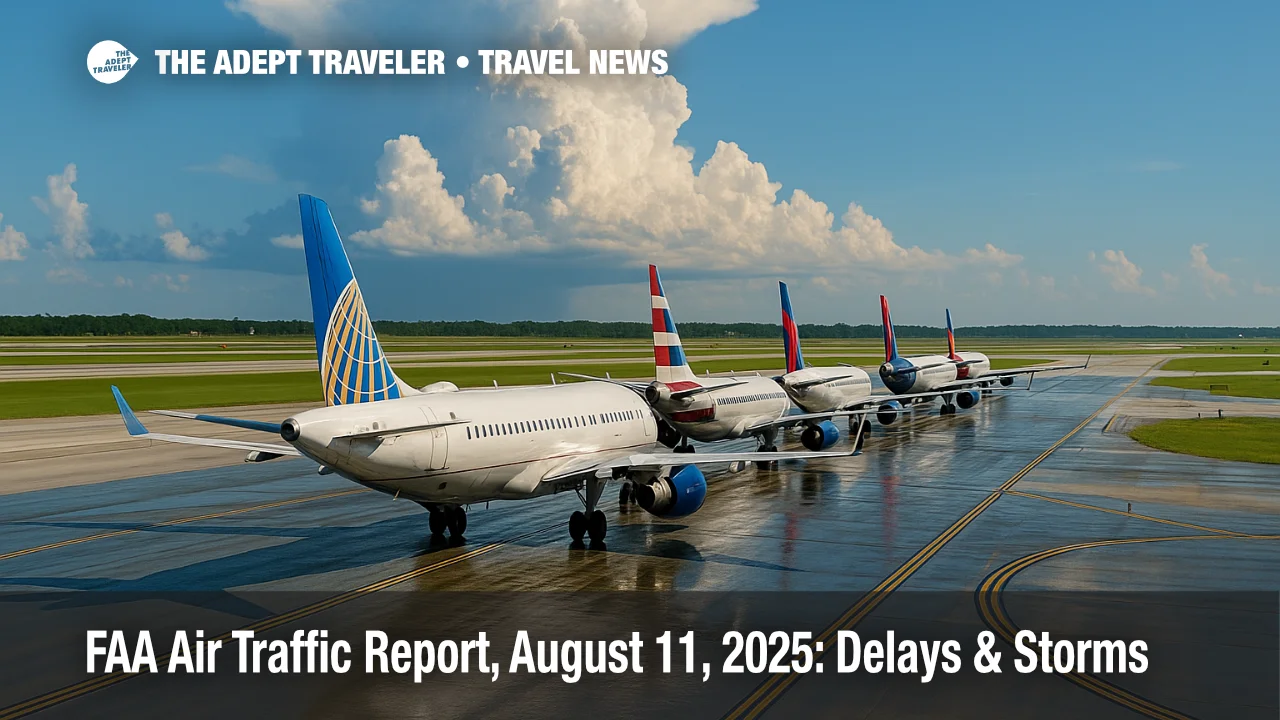FAA Air Traffic Report, August 11, 2025: Delays & Storms

San Francisco International Airport (SFO) entered a Collaborative Decision Making Ground Delay Program late this morning after low ceilings reduced arrival rates. The program is scheduled to meter arrivals from 1030 a.m. to 259 p.m. CDT, 830 a.m. to 1259 p.m. PDT, with average delays near 55 minutes and a maximum reported delay of 146 minutes. Elsewhere, thunderstorms are expected to disrupt flows at Atlanta and Florida hubs this afternoon and evening, while a Cape Canaveral launch window temporarily constrains Atlantic routes. Travelers should expect pop-up reroutes and periodic holds. Airlines continue to adjust schedules as conditions evolve.
Key Points
- Why it matters: SFO's low ceilings triggered a morning GDP, adding 30 to 90 minutes for many arrivals.
- Travel impact: ATL and major Florida hubs may see afternoon ground programs and SWAP routes as storms build.
- What's next: Atlantic and Gulf route closures are probable into the evening, with another planning update after 815 a.m. CDT, 615 a.m. PDT.
Snapshot
Today's FAA operations plan highlights three drivers. First, SFO's morning Ground Delay Program meters arrivals through early afternoon Central time as marine layer ceilings lift. Second, thunderstorm clusters are forecast to affect Atlanta and Florida terminals from early afternoon into the late-day push, prompting potential ground stops, delay programs, and storm-avoidance routing. Third, a Cape Canaveral launch window around 715 to 843 a.m. CDT, 515 to 643 a.m. PDT briefly reduces Atlantic route availability and adds miles-in-trail on Florida flows. Oceanic and Gulf route closures are probable this evening, with the FAA signaling Airspace Flow Programs if convective coverage expands.
Background
The Air Traffic Control System Command Center issues a rolling operations plan that frames expected constraints and the tools to manage them, including Ground Delay Programs when airport arrival capacity drops. Under a GDP, flights receive new, metered departure times to smooth demand and reduce airborne holding. The FAA's August 11 plan calls out thunderstorms across multiple centers in the Southeast, low ceilings in the Bay Area, and temporary airspace constraints for a Cape launch, all common summer triggers. Yesterday, for example, the Command Center converted a Chicago O'Hare ground stop into a GDP with a variable rate as weather evolved over the hub. These adjustments are routine but can ripple across the system during bank times. For the latest planning notes, see the FAA's operations plan page (ATCSCC operations plan: https://www.fly.faa.gov/adv/adv_spt.jsp).
Latest Developments
SFO GDP caps morning arrivals, average delay near 55 minutes
SFO's CDM Ground Delay Program went into effect at 750 a.m. CDT, 550 a.m. PDT, metering arrivals between 1030 a.m. and 259 p.m. CDT, 830 a.m. and 1259 p.m. PDT. Program rates step from 36 to 45 arrivals per hour as ceilings improve, with an average delay of about 55 minutes and a maximum near 146 minutes. The advisory cites weather, low ceilings, and a 28-arrival, 01-departure configuration. If improvement holds, the Command Center can lift the program earlier. Check your airline app or the FAA advisory feed for gate-time updates (SFO GDP advisory: https://www.fly.faa.gov/adv/advADB.jsp).
Southeast storms and launch window complicate Florida flows
The FAA flags thunderstorms affecting Houston, Atlanta, and Florida metroplex airports through tonight, with possible ground programs after 1100 a.m. CDT, 900 a.m. PDT at Hartsfield-Jackson Atlanta International Airport (ATL) and after 200 p.m. CDT, 1200 p.m. PDT at Orlando International (MCO), Tampa International (TPA), Miami International (MIA), Fort Lauderdale-Hollywood (FLL), and Palm Beach International (PBI). A Cape Canaveral launch window from 715 to 843 a.m. CDT, 515 to 643 a.m. PDT adds short-term Atlantic route constraints, with additional oceanic and Gulf route closures probable into the evening. The Storm Prediction Center also outlines widespread thunderstorm potential across the Peninsula today (SPC day-1 outlook: https://www.spc.noaa.gov/products/outlook/day1otlk.html).
Analysis
Summer pattern, familiar playbook. SFO's marine layer reduces arrival rates during the morning bank, so a limited-window GDP smooths demand into early afternoon Central time. That typically keeps most flights on the ground longer rather than holding in the air, which saves fuel and maintains runway throughput once ceilings lift. In the Southeast, scattered to numerous storms build along sea breezes and outflow boundaries. The Command Center's plan to use SWAP routes, CDRs, and regional caps after early afternoon should keep flows moving but will add miles and sporadic delays, especially on Florida inbounds. The Cape window's impact is brief but can force Atlantic reroutes during the morning push into MCO and TPA. If convective coverage expands toward the evening peak, expect Airspace Flow Programs on Florida arrivals and more oceanic and Gulf closures, along with pop-up restrictions at ATL. Keep an eye on airline push notifications and the FAA NAS Status map for evolving holds and reroutes.
Final Thoughts
Plan on extra time if you are flying into SFO before early afternoon Central time, and build slack for Florida and Atlanta trips this evening. Monitor your carrier's app for revised departure clearances from Ground Delay Programs, and leave room for gate changes or longer taxi-out during thunderstorm cells. If you are connecting through Florida, consider earlier flights to avoid late-day storm peaks. We will keep watching the Command Center updates and highlight any new ground programs or AFPs in our next FAA air traffic report.
